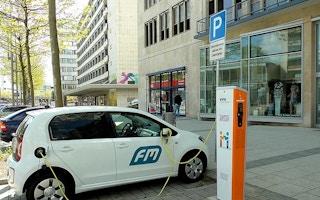Australian Energy Minister Josh Frydenberg has it right when he says that electric vehicles will be the sustainable transport choice of the future. Electric cars are here to stay, and the Turnbull Government should support the industry to get traction in Australia.
To continue reading, subscribe to Eco‑Business.
There's something for everyone. We offer a range of subscription plans.
- Access our stories and receive our Insights Weekly newsletter with the free EB Member plan.
- Unlock unlimited access to our content and archive with EB Circle.
- Publish your content with EB Premium.
What the naysayers are missing is this:
We are facing a full-scale shift in terms of our transport paradigm. And if your job has anything to do with transportation, you need to be thinking about it now.
Car manufacturer. Rental company. Mechanic. Insurance company. Urban designer. Government. Property developer - anyone whose job assumes that we move people around in a certain way.
Why?
First, American car manufacturer GM is aiming to have self-driving vehicles ready for consumers in “quarters, not years”.
Secon, Bob Lutz, former Vice Chair of GM, EVP of Ford, EVP Sales BMW says that “the era of the human-driven automobile, its repair facilities, its dealerships… all will be gone in 20 years”.
Finally, technology think-tank RethinkX projects 95 per cent of all miles travelled in the US will be by autonomous electric vehicle by 2030.
In an autonomous future, the cost per trip will go down so much that it would be ridiculous to own your own car.
Instead, you access the vehicle you need at any given time from fleets of roving, on-demand vehicles. Heading to work in the morning? Hit a button on your phone and a single-person pod shows up to take you there. Heading to the mountains? Order up that SUV. No parking. No tickets. No drink driving. No maintenance. No depreciation. No insurance.
What GM, Tesla, Uber and other car manufacturers are all acutely aware of is that autonomous vehicles are an existential threat and a massive business opportunity.
Autonomous vehicles could also spell the end of the on-demand ride-sharing sector. Lyft, for instance, is a US-based ridesharing service currently available in about 300 US cities and making its way to Australia in 2018 as a competitor to Uber.
But If Lyft gets autonomous vehicles before Uber, their prices will drop by 50 per cent while Uber struggles to subsidise their already low prices.
GM’s Bob Lutz predicts that human-driven vehicles will be legislated off the highways in 15-20 years.
“The tipping point will come when 20 to 30 per cent of vehicles are fully autonomous. Countries will look at the accident statistics and figure out that human drivers are causing 99.9 per cent of the accidents,” he says.
Last year, Intel projected that the economic opportunity from self-driving cars will be USD$7 trillion by 2050. By 2035 — the base year of the study — they’re saying it will already be up to $800 billion.
“
We are facing a full-scale shift in terms of our transport paradigm. And if your job has anything to do with transportation, you need to be thinking about it now.
We’re looking at a dramatic transformation of use cases for mobility. Right now, under the human car model, most of us own our own vehicle, park it at our home, drive it to work etc.
Even though work commutes represent 99 per cent of our travel, we have an SUV because once a year we go skiing and we need to be able to fit all the kids and the gear. We’re at risk of drink driving, theft, speeding and parking tickets, and accidents.
Fully autonomous electric vehicles are already on the streets today. In the future, nobody will have their own car. So, when you go to a new city you just plug into that city’s autonomous transportation system, rather than renting a car.
So how does this shift affect the industries mentioned above?
If you are a car manufacturer, it’s obvious that it is an existential threat. If you’re not quick enough to market with a viable autonomous offering, you’re done.
Automotive insurance providers face dramatic changes as well. There’s the change in use case already mentioned — basically a shift to transportation-as-a-service — meaning insurers need to cover the fleets and not the individuals.
The risk profile of an autonomous vehicle is dramatically different — and lower — than that of a human-driven vehicle. The Intel study suggests around 585,000 lives could be saved by the shift to autonomous vehicles between 2035 and 2045.
State Governments will need to think about how they generate tax revenue to maintain road infrastructure.
Australia’s vast distances mean thousands of truck drivers are employed to transport goods. What kind of social protections or retraining options will be offered to out-of-work drivers?
The Federal Government needs to consider these massive challenges.
Josh Frydenberg has it right. The conversation needs to start now. The transportation hurricane is coming and everything changes with it.
Kaila Colbin is the Director of SingularityU Australia Summit, which will be held in Sydney from 19 to 21 February 2018.











